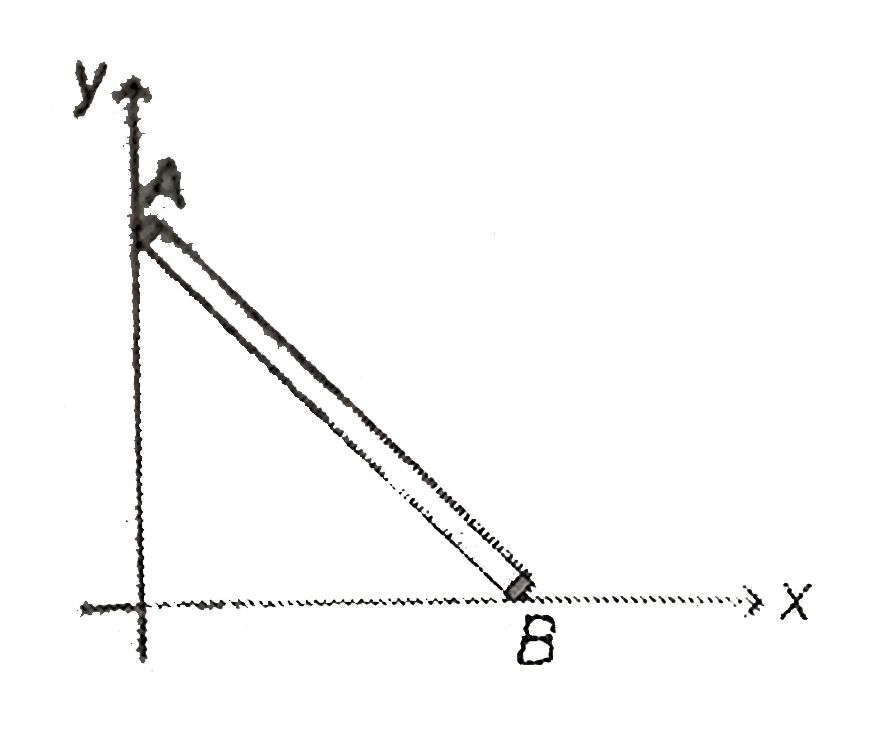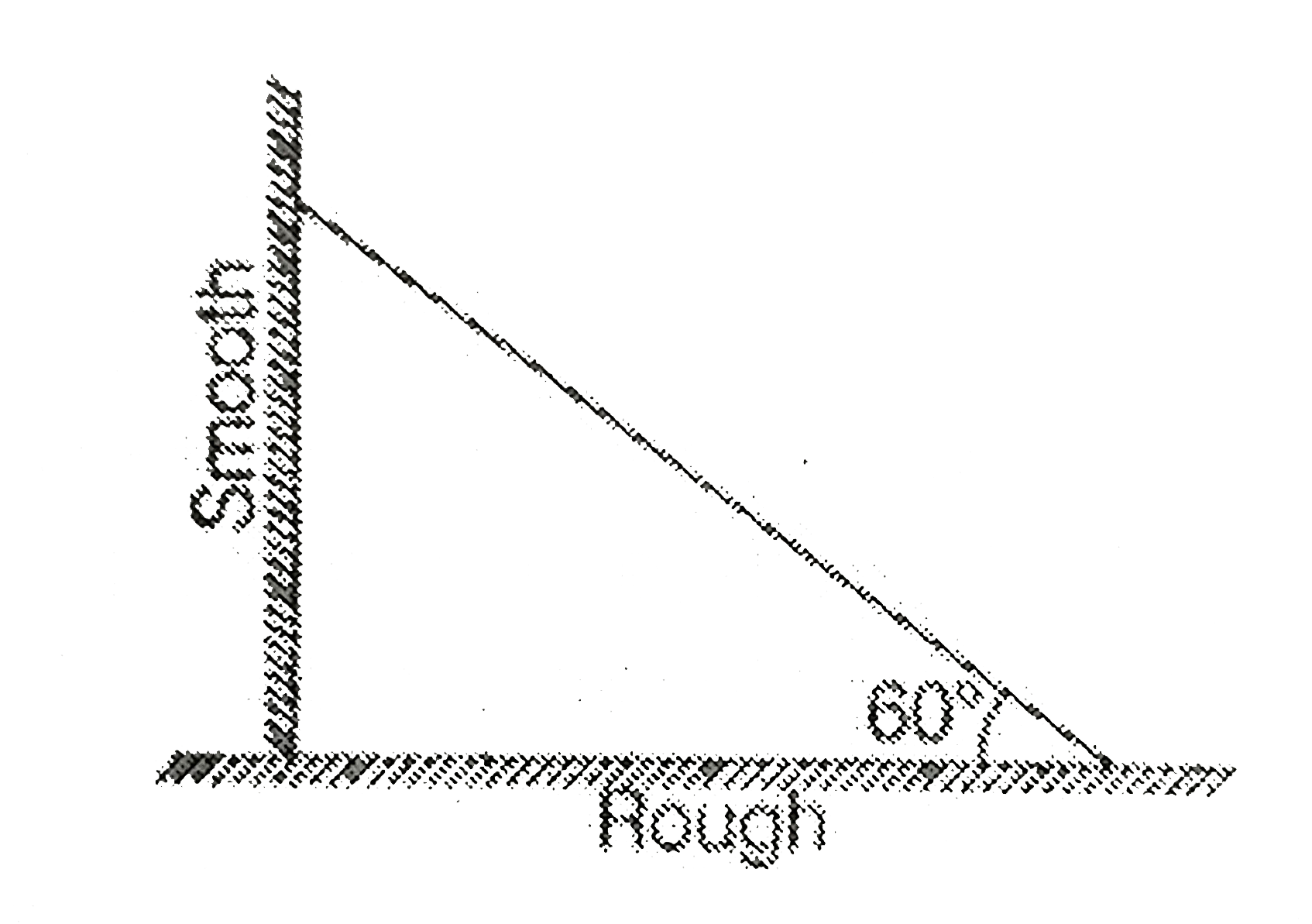A uniform ladder of mass 10 kg leans against a smooth vertical wall making an angle of with it. The other end rests on a rough horizontal floor. Find the normal force and the frictional force that the floor exerts on the ladder
To solve the problem of the uniform ladder leaning against a smooth vertical wall, we will follow these steps:
Step 1: Identify the Forces Acting on the Ladder
1. Weight (W): The weight of the ladder acts downwards at its center of mass. Since the mass of the ladder is 10 kg, the weight is given by:
W=mg=10kg×9.8m/s2=98N
2. Normal Force (N2): The normal force exerted by the ground acts upwards at the base of the ladder.
3. Normal Force (N1): The normal force exerted by the wall acts horizontally towards the ladder.
4. Frictional Force (f): The frictional force at the base of the ladder acts horizontally in the opposite direction to the tendency of motion.
Step 2: Apply the Conditions of Equilibrium
Since the ladder is in equilibrium, we can apply the following conditions:
- The sum of forces in the horizontal direction (ΣFx) is zero.
- The sum of forces in the vertical direction (ΣFy) is zero.
- The sum of torques (Στ) about any point is zero.
Step 3: Analyze Forces in the Horizontal Direction
From the horizontal forces:
N1−f=0⇒N1=f(Equation 1)
Step 4: Analyze Forces in the Vertical Direction
From the vertical forces:
N2−W=0⇒N2=W
Substituting the value of W:
N2=98N(This is our first answer)
Step 5: Analyze Torques
To find the relationship between N1 and f, we can take torques about point A (the base of the ladder):
- The torque due to the weight (W) acts at a distance from point A.
- The torque due to N1 acts at the height of the ladder.
Let’s denote the length of the ladder as L. The height (h) and base (b) can be expressed using trigonometric functions:
- h=Lsin(53∘)
- b=Lcos(53∘)
The torque due to the weight W about point A is:
τW=W⋅(L2cos(53∘))
The torque due to N1 about point A is:
τN1=N1⋅(Lsin(53∘))
Setting the torques equal for equilibrium:
N1⋅(Lsin(53∘))=W⋅(L2cos(53∘))
Step 6: Simplify the Torque Equation
Canceling L from both sides:
N1⋅sin(53∘)=W2⋅cos(53∘)
Substituting W = 98 N:
N1⋅sin(53∘)=982⋅cos(53∘)
N1⋅sin(53∘)=49⋅cos(53∘)
Step 7: Solve for N1
Using the values of sin(53∘)=45 and cos(53∘)=35:
N1⋅45=49⋅35
N1⋅4=49⋅3
N1=1474=36.75N
Step 8: Find the Frictional Force
From Equation 1:
f=N1=36.75N
Final Answers
- Normal Force (N2) = 98 N
- Frictional Force (f) = 36.75 N
1. Weight (W): The weight of the ladder acts downwards at its center of mass. Since the mass of the ladder is 10 kg, the weight is given by:
W=mg=10kg×9.8m/s2=98N
2. Normal Force (N2): The normal force exerted by the ground acts upwards at the base of the ladder.
3. Normal Force (N1): The normal force exerted by the wall acts horizontally towards the ladder.
4. Frictional Force (f): The frictional force at the base of the ladder acts horizontally in the opposite direction to the tendency of motion.
Since the ladder is in equilibrium, we can apply the following conditions:
- The sum of forces in the horizontal direction (ΣFx) is zero.
- The sum of forces in the vertical direction (ΣFy) is zero.
- The sum of torques (Στ) about any point is zero.
From the horizontal forces:
N1−f=0⇒N1=f(Equation 1)
From the vertical forces:
N2−W=0⇒N2=W
Substituting the value of W:
N2=98N(This is our first answer)
To find the relationship between N1 and f, we can take torques about point A (the base of the ladder):
- The torque due to the weight (W) acts at a distance from point A.
- The torque due to N1 acts at the height of the ladder.
- h=Lsin(53∘)
- b=Lcos(53∘)
τW=W⋅(L2cos(53∘))
The torque due to N1 about point A is:
τN1=N1⋅(Lsin(53∘))
N1⋅(Lsin(53∘))=W⋅(L2cos(53∘))
Canceling L from both sides:
N1⋅sin(53∘)=W2⋅cos(53∘)
Substituting W = 98 N:
N1⋅sin(53∘)=982⋅cos(53∘)
N1⋅sin(53∘)=49⋅cos(53∘)
Using the values of sin(53∘)=45 and cos(53∘)=35:
N1⋅45=49⋅35
N1⋅4=49⋅3
N1=1474=36.75N
From Equation 1:
f=N1=36.75N
- Normal Force (N2) = 98 N
- Frictional Force (f) = 36.75 N
Topper's Solved these Questions
- ROTATIONAL MECHANICSBOOK - HC VERMA ENGLISHCHAPTER - ROTATIONAL MECHANICSEXERCISE - Objective -1
26 Videos
- ROTATIONAL MECHANICSBOOK - HC VERMA ENGLISHCHAPTER - ROTATIONAL MECHANICSEXERCISE - Objective -2
14 Videos
- ROTATIONAL MECHANICSBOOK - HC VERMA ENGLISHCHAPTER - ROTATIONAL MECHANICSEXERCISE - Questions for short Answer
21 Videos
- REST AND MOTION : KINEMATICSBOOK - HC VERMA ENGLISHCHAPTER - REST AND MOTION : KINEMATICSEXERCISE - Question for short Answer
13 Videos
- SIMPLE HARMONIC MOTIONBOOK - HC VERMA ENGLISHCHAPTER - SIMPLE HARMONIC MOTIONEXERCISE - Question for short Answer
15 Videos
Similar Questions
The length of a uniform ladder of mass m is 1. It leans against a smooth wall making an angle θ with the horizontal. What should be the force of friction between the floor and ladder so that the ladder does not slip ?
View SolutionA uniform ladder of length L and mass m1 rests against a frictionless wall. The ladder makes an angle θ with the horizontal. (a) Find the horizontal and vertical forces the ground exerts on the base of the ladder when a firefighter of mass m2 is a distance x from the bottom. (b) If the ladder is just on the verge of slipping when the firefighter is a distance d from the bottom, what is the coefficient of static friction between ladder and ground?
View Solution
Knowledge Check
A block of mass 2kg rests on a rough inclined plane making an angle of 30∘ with the horizontal. The coefficient of static friction between the block and the plane is 0.7. The frictional force on the block is
A10.3NB23.8NC11.9ND6.3NA block of mass 3 kg rests on a rough inclined plane making an angle of 30∘. With the horizontal. The coefficient of static friction between the block and the plane is 0.7. The frictional force on the block is
A9.8 NB0.7×9.8×√3 NC9.8×√3 ND0.7×9.8 N
A uniform ladder of length 10.0 m and mas 16.0 kg is resting against a vertical wall making an angle of 37∘ with it. An electrician weighing 60.0 kg climbs up the ladder. If the stays on the ladder at a point 8.00 m from the lower end, will be normal force and the force of friction on the ladder by the ground? What should be the minimum coefficient of friction for the electrician to work safely?
View SolutionA rigid rod leans against a vertical wall (y-axis) as shwon in figure. The other end of the rod is ion the horizontal floor. Point A is pushed downwards with constant velocity. Path of the centre of the rod is

View SolutionA uniform ladder which is 5m long has a mass of 25kg , leans with its upper end against a smooth vertical wall and its lower end on rough ground. The bottom of the ladder is 3m from the wall. Calculate the frictional force between the ladder and the ground . (g=10ms−2)
View SolutionA uniform ladder of length 10.0 m and mass 16.0 kg is resting against a vertical smooth wall making an angle of 37∘ with it. An electrian weighing 60.0 kg climbs up the ladder. If the stays on the ladder at a point 8.00 m from the lower end, what will be normal force and the force of friction on the ladder by the ground? What should be the minimum coefficient of friction for the electrician to work safely?
View SolutionA ladder of mass 10kg is held at reat against a smooth wall on a rough ground as shown in figure. The normal reaction between the wall and the ladder is

View SolutionA block of mass 2kg rests on a rough inclined plane making an angle of 30∘ with the horizontal. The coefficient of static friction between the block and the plane is 0.7. The frictional force on the block is
View Solution
